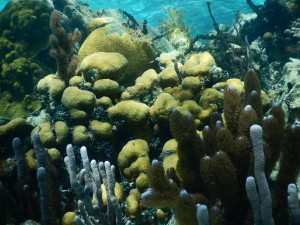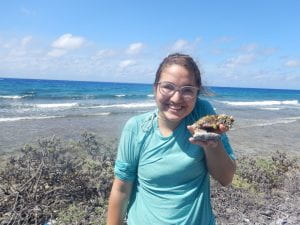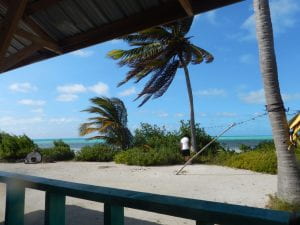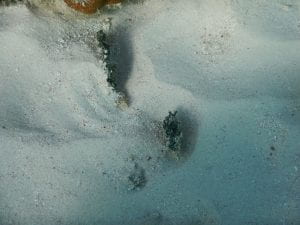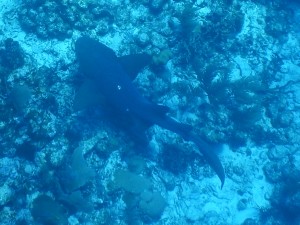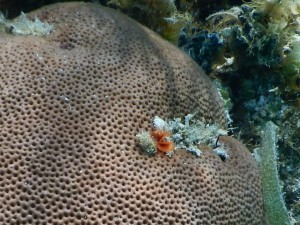The rainforest and the reef are similar and dissimilar in several ways. Both ecosystems hold incredible biodiversity, experience similar negative anthropogenic impacts, and exist in oligotrophic surroundings. The reason biodiversity is high for each has to do with the location of rainforests and reefs. Both are found low latitudes, where weather and temperature are more constant than at higher latitudes and the impact of the sun is at its fullest. The structural complexity of each provides a wide array of niches to be filled by different organisms. Both habitats are under severe threat from human activities, even if those activities are different. Though, the goal is the same, to extract resources. The soils of tropical rainforests are nutrient and nitrogen poor and the same goes for reefs. The turnover rate in both ecosystems is so large that these nutrients are almost instantly ingested by the organisms living on the forest floor or in the benthos, where it is recycled in a microbial loop.
There are differences also in the environment, types of life, and in the effects of humans. As terrestrial organisms, we are built for living on land and can be quite awkward and clumsy in the sea. The ocean is an entirely different medium, made up of salty water. To fully explore the reefs, a human must strap on fake fins and be able to hold their breath for long periods of time, or utilize scuba. Land is a remarkably easier place to do field work for most people. The types of life found in each area are also different. Insects do not inhabit the oceans but are found on every single continent. While marine fish make up a great portion of the species in the sea, as do marine mammals, most if not all are absent from the rainforest’s rivers. Reefs are probably the more fragile ecosystem, since a large part of the functionality of a reef is dependent upon the health of its main reef builders, stony corals. The forests of the Chiquibul face a number of anthropogenic threats, such as selective and indiscriminate logging, harvesting of Xate, hunting, poaching, and mining. While these forests do face some threat from global warming, its main threat is extraction. But for reefs, human extraction, pollution, as well as global warming are likely all equally threatening. Stony corals live in symbiosis with tiny dinoflagellate algae, and this symbiosis is fragile and easily susceptible to stressors in the environment. If the stony corals are unhealthy, this can cause huge changes to this ecosystem, such as a loss of architectural complexity, harms to reef fish populations and dynamics, and erosion along coastlines. The ocean also serves as a dumpster for humanity’s trash and it seems that even a place like Glover’s can be affected, whereas trash cannot just drift into the Chiquibul.
Overall I observed all of these similarities and differences between these two ecosystems. The forests may stand taller than much of the reef landscape, but it is wise not to be fooled. The outer reef contains multitudes of boulders and nooks and crannies, creating this complex and diverse habitat. We were fortunate enough to see several colonies of Acropora palmata, a beautiful, large branching coral that was nearly wiped out by White Band Disease. Once, this species formed a zone that mimicked the forest, but now, these corals are dispersed across the outer reef. Noise is another factor to consider. The forest was never still and never silent. From crickets to cicadas, from howler monkeys to the sounds of the wind blowing through the trees, there was never a time when anything stopped. In the sea however, noises were harder to hear, and were occasionally absent. Down in the depths of the outer reef, an eerie but calming silence envelops you and nearly makes you forget that you have to go back to the surface in order to draw another breath.
I am quite biased towards the reef and must say that was my favorite week. I love the ocean, and the challenges that it presents to a land creature like myself. I enjoyed every aspect of the entire trip however, and found that hiking 13.25 miles in rain boots isn’t so bad as long as you have a chipper attitude and an amazing group of people surrounding you. Michael and Sam, in their enthusiasm for insects, and Adrienne’s funny antics towards them, made me more fully appreciate their existence. While I will never pick up a cockroach, I still have a newly found respect for them. I also think that monkey hoppers are actually pretty cute. My baseline for ant size has definitely been shifted to a larger perspective. I’m excited to go home and see tiny ants and be thankful they aren’t the large soldier ants we so lovingly harassed. The reef though, is where I think I am the happiest. The large colorful and beautiful birds of the Chiquibul morph into colorful reef fishes. The large trees turn to acroporas and boulder mounds. Predatory jaguars and other cats turn into the sharks and barracudas that silently cut through the water. In the end though, I love both places, and would never turn down an opportunity to explore both even more.
A few things surprised me. Hiking 13.25 miles in one day in rain boots wasn’t so bad after all. I learned that trying to count intersect points of a quadrat in five feet of water is extremely difficult, even in the slightest of waves. I can never un-see Michael putting that bee larvae in his mouth. I also learned I am definitely not a morning person. I would tell myself literally every night that I would get up early to go bird watching or to write my blogs, but I always got up at the last second, threw on some clothes, and headed to breakfast. Cold showers are necessary and will make you wonder why you ever took a hot shower. Bees are really cool and are diverse and variable in form, and I’ll never forget that little metallic green orchid bee. I may never see one again. I shall never forget our friend Clivus. Most of all, what will definitely stick with me over the years is the awesome group of people I got to explore Belize with. This group was amazing and every person played a part in making the dynamic fantastic and crazy. Throughout my time in Belize, I met some amazing people, from Lauren and Boris at Las Cuevas, to Javier and Herbie at Glover’s Reef. I wouldn’t change anything about this course (even though the transportation was definitely not on par, our group made the best of it!) because each activity is meant to challenge our perceptions of nature and how to turn observations and experiments into usable data. I will look back on this trip with fond memories.
Postcards from Randy. See me. Pupae. Where is she (Batman voiceover). Mrrph.
